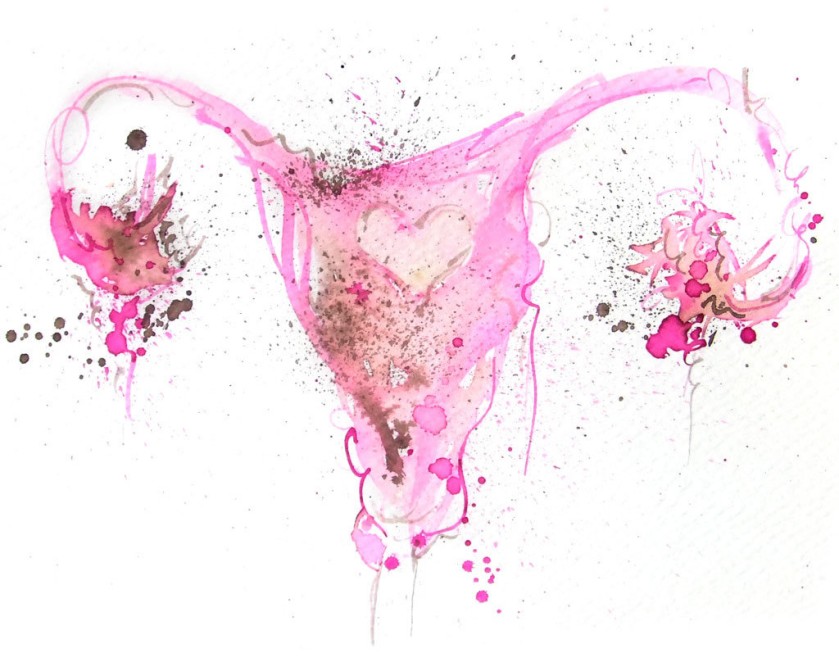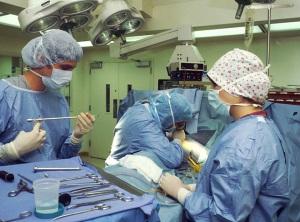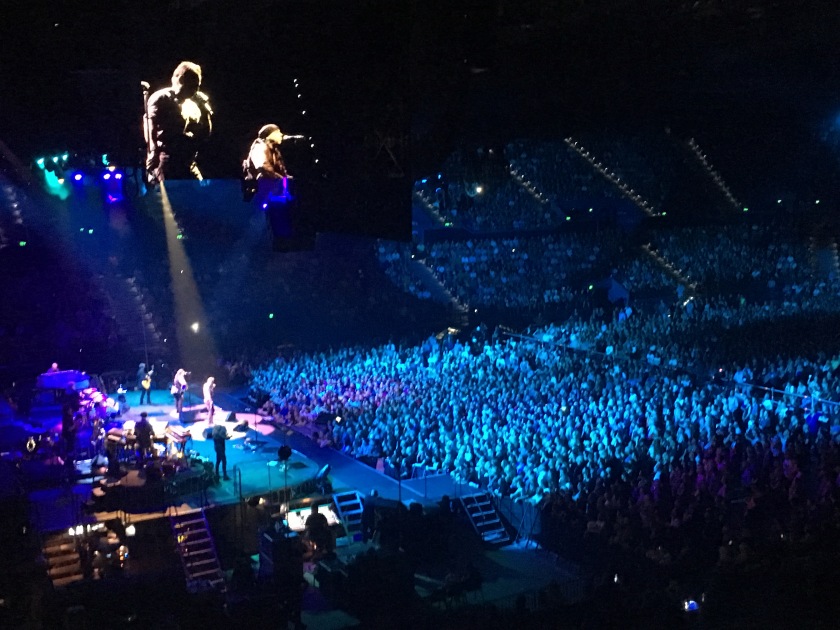The Realities of Being A Nurse With Endometriosis

Drain the pressure from the swelling
The sensation’s overwhelming
Give me a long kiss goodnight and everything will be alright
Tell me that I won’t feel a thing
So give me Novacaine.
– Give Me Novacaine, Green Day.
The pain has been ebbing and building for two hours when it changes to constant, and stabbing. The feeling of nausea is subtle, but it too grows, as does a hazy feeling inside my head that is the precursor to dizziness. I am sitting at a table, where it’s easy enough to hide these things, and I occupy myself with the lists and tickets in front of me, I smile at people as they walk in – no one knows except the person beside me, because I have attached a blister sheet of paracetamol to my clipboard. We all laughed at first, about how nothing would stop me being at this event, not pain, not anything, and so I have meds on hand, naturally. When the first wave of intense nausea comes my hand rushes to my mouth. My colleague tenses and hands me a bin, but I have no desire to vomit in a bin in front of everyone, especially as I see my doctor seated in the back row in front of me – I pray he doesn’t turn around and see me. When I return from the bathroom I sit on the floor at the back, feeling as though I may pass out. I recognise a pre-syncopal episode when I see one, and now I am feeling it. As I sit I look at the back of my doctor’s head, willing it to stay turned away from me. I can feel the eyes of my friends on me, worried, wondering what they should do. I sit filled with guilt that they are worrying about me, instead diverting their full attention to enjoying the fruits of their labour. Don’t look back, I think to myself, watching his head; don’t look back and see me.
I can already hear your question, reader, why didn’t I want him to see? What luck, I hear you say, to be feeling horribly sick with an endometriosis flare up and be sitting in an event surrounded by nothing but other women with endo and your doctor. The thing is, the very last thing I ever want is to show other people how sick I am. I wonder if it’s because I want to hide it, because I don’t want pity, or if it’s denial. If no one notices, it can’t be that bad, right? It’s learned behaviour from my days as a teenage bulimic – showing symptoms was synonymous with showing my secret and I avoided it as much as possible.
Perhaps it’s because my job involves caring for other people, and when taking care of others we instinctively hide our own distractions so that this person knows we are focused on their needs. This relationship won’t work nearly as well if the other person thinks they need to take care of us. I can still remember a shift as a student nurse where I had no choice but to go home sick because I couldn’t push aside how ill I felt anymore, I had pushed too far and nearly blacked out in the middle of a blood sugar check. The patient in question looked up at me and asked “You right nurse?”. I nodded and smiled, telling him that he needn’t worry about me, I was making sure he was okay. I finished – just. As soon as I wrote down that value I walked quickly to the bathroom where I felt my legs give way and I sat on the floor until things became clearer. Even then I knew that I couldn’t let my patients see my pain, ever, because I was not in the business of patients worrying about me when it’s my job to take care of them.
Nurses make the worst patients, don’t they?
When I started nursing school I saw patients with the same problem, the kind that told me they were fine and wanted to go home, and then nearly passed out walking to the shower. Patients who didn’t want to bother me by asking for pain medication and only relented when they were wracked with pain and I held their hand as my colleagues administered strong pain medicines. If I hadn’t already appreciated the danger of denying symptoms before then, nursing school certainly reiterated it. But it didn’t seem to be enough, I still reverted to my standard defence mechanism. Final semester of nursing school, September, my pain which had been well controlled for close to eighteen months, began to act much like an unruly child. Since my surgery and IUD insertion, and a few months of hellish pain, my overall pain was reduced 90% of the time. Once or twice a month I may have gotten pain bad enough to effect my functioning, and a few times a month some pain in response to stress or too much sugar when my best friends and I tried a spree of new dessert places. It was more than manageable. I was doing so well that I joined QENDO as a support worker, flew through my accelerated nursing course, and dreamed lots of dreams that seemed out of reach before – I hadn’t thought I could stand for hours in an operating theatre as a scrub nurse in pain, but now the pain was gone. I fell crazy in love with theatre nursing, and thought the feeling of joy would never go away.
In my final placement everything went completely and categorically to shit. The pain was back most days each week, some mild, some moderate, and some straight from the fiery depths of hell. Those days, combined with the stress of a placement that made me more anxious each shift, made lunch breaks no longer for lunch, but for finding a bathroom to cry or have a panic attack in where no one would see. I hadn’t experienced pain so horrific since before I was diagnosed. I blamed it on my placement – anxiety is fuel for a flare sometimes, surely it’s because of that, I thought. Placement was over, and still the pain stayed. I blamed it on job hunting – that was stressful too. By February I had secured a graduate job for March, my first real nursing job, and yet the pain did not go away until there I was sitting on the floor of a lecture room at UQ trying not to pass out. There was nothing left to blame – I loved my new job, my new role in QENDO, I finally had my own place. There was one question now – what the hell was happening to me?
The task of tackling nursing and endometriosis is a challenging one. At times I feel like I know too much because of my nursing background, and only sometimes is it an asset instead of a liability. It is great to know exactly what doctors are saying to me, or to be able to advocate for myself because I do it all the time for patients, but sometimes I don’t want to know – knowledge can be both a blessing and a curse. The greater issue is one I get asked about a lot – how can you work in so much pain?
The truth is that nursing is the best thing that ever happened to me for coping with pain. When I am in my uniform, or my scrubs, on a ward or in an OR, I am someone different. My endometriosis doesn’t exist for eight hours. I feel it tug and pull, like a child on its mother’s skirt, but I do not look down. By some feat of strength I can push the pain into the background, as long as I keep moving and keep working – and a shift at my hospital leaves little time to be idle. My work is what helps me survive. Being a nurse makes me feel in control because when something happens I can intervene. Pain? Have some PRNs. Nauseas? Have some antiemetics. Strange, new symptoms? Let me page the resident for you and reassure you that everything will be okay. When I feel any of these things myself, I feel powerless, sometimes there is nothing I can do. The pain of endometriosis is such that often no painkillers touch it, you feel violently nauseous, pale and dizzy, and the weight of it crushes you. The feeling of stasis makes me uncomfortable, anxious even, and so when my endometriosis flares up I feel out of control, it slips through my fingers. If I didn’t have my work, I’m afraid of what I would do to get that control back. Nursing is better than any pain killer, better than anaesthesia – for just eight hours.
And there in lies the problem, it’s temporary. As soon as I get home and there are no more buzzers to answer, or IVs to change, or people to take care of I have to take care of myself – and I am really bad at it. If I treated patients the way I do myself, if I ignored their symptoms, denied them pain killers, or just let them feel sick, I would be a terrible nurse. So why do I do it to myself? From talking to a lot of other endo sisters, I know I am not alone in this problem. Part of me wonders if it’s because we have been doubted, pushed aside or dismissed for so long that we cannot indulge ourselves, because we feel guilt about being selfish, or worried that people will think we’re “sick again” and tire of us. If we pretend everything is fine and act normal, no one can hurt us with a lack of understanding. Perhaps it is a strong desire to just be normal, after being sick for so long. There is an element of denial. I recognise that in myself – I didn’t want to believe that the pain was “back”, it was just a little flare up, something I did, something I needed to fix. If the pain wasn’t back then no one needed to know, and I could keep pretending.
As carers we need to remember to engage in self care. We must refute the notion once and for all that self care is selfish, or indulgent, or some kind of privilege we must earn. It is none of these things, it is a necessity. How can we as nurses, or health professionals, or counsellors, or parents expect to care for our charges if we have not taken the time to care for ourselves? It isn’t easy, as part of our role we are often conditioned to put others before ourselves, and that attitude doesn’t leave us at the door as we leave work. It can be an ongoing challenge to change this attitude, to learn to say no and take a minute to ourselves, to stop denying. I have no easy answers for you on how to achieve this, it is my own project at the moment, I am learning these things for myself. It has been helpful to ask myself – if I were my patient, would I accept this treatment?
I encourage you to create your own self care toolbox, whether you’re a nurse, you have endo, or you’re a special hybrid nurse-endo sister like me. For endometriosis, every professional I have had the pleasure of talking to has recommended creating such a tool box. Who are your people? What can you do for pain relief, both pharmacological and non-pharmacological? What are your coping strategies? Who are your endo team, the health professionals you can access to manage pain and stress? Most importantly, be kind to yourself – if you live with endo and you generally exist and function, even just a little, you are doing so incredibly well. It is not an easy burden to bear, but I have seen so many of us bear it with grace and optimism.
And so it is with my own advice in hand I once again embark on the task of controlling my pain; I venture into the medical world not as RN, but as patient, to once more find a new GP, despite it being my least favourite task, because pain is no one’s friend. I lived in pain before my diagnosis for so long, so I owe it to myself not to live that way again. I owe it to myself not to pretend that there is nothing wrong, no matter how easy it is to slip back into that habit.
It’s okay for him to turn around now.








 You’d be forgiven for not knowing at all what a perioperative nurse does if you spend a lot of time watching Grey’s Anatomy, House MD, or Pulse. In the world of television medicine, doctors do their own jobs as well as a good deal of the role delegated to nurses but balk at hygiene cares with a terse “that’s a nurse’s job” as though our years of training equip us for nothing more than these (albeit extremely important) tasks. When you move from the ward to the operating room, we become even more scarce. Grey’s Anatomy generally features one scrub nurse and she’s rarely acknowledged (despite the actor being a scrub nurse in real life – a way cooler story!) and scout or circulating nurses are rarely even present let alone allowed speaking roles. House borders on comical in it’s surgical depictions – with House’s staff frequently performing surgery despite clearly being of the internal medicine variety – immunologist, neurologist, nephrologist/infectious disease – and often with no theatre staff. Now that’s a violation of ACORN standards if I ever did see one….
You’d be forgiven for not knowing at all what a perioperative nurse does if you spend a lot of time watching Grey’s Anatomy, House MD, or Pulse. In the world of television medicine, doctors do their own jobs as well as a good deal of the role delegated to nurses but balk at hygiene cares with a terse “that’s a nurse’s job” as though our years of training equip us for nothing more than these (albeit extremely important) tasks. When you move from the ward to the operating room, we become even more scarce. Grey’s Anatomy generally features one scrub nurse and she’s rarely acknowledged (despite the actor being a scrub nurse in real life – a way cooler story!) and scout or circulating nurses are rarely even present let alone allowed speaking roles. House borders on comical in it’s surgical depictions – with House’s staff frequently performing surgery despite clearly being of the internal medicine variety – immunologist, neurologist, nephrologist/infectious disease – and often with no theatre staff. Now that’s a violation of ACORN standards if I ever did see one….






